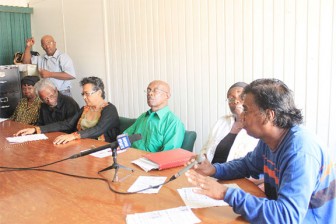The move to discount Independence Park as the monument site for the 1823 slave rebellion continues to spark opposition from African groups, which yesterday said that the location chosen by the Culture Ministry is disrespectful to their ancestors.
At a news conference at City Hall yesterday, the groups argued that the monument is being disconnected from the site of insurrection without realistic consultation from the Guyanese society and the African groups.
Present at the press conference were members of the All African Guyanese Council, African Cultural and Deve-lopment Association, Pan-African Movement, African Welfare Council, the Guyana Institute of Historical Research, and the People’s Parliament. These groups have formed a coalition to establish the 1823 monument in its rightful place.

Earlier in the month, Culture Minister Dr Frank Anthony defended government’s decision to erect the monument along Carifesta Avenue, saying that the “prominent” site was chosen after an invitation for the public’s input yielded no responses.
“In the end, because we didn’t have any persons coming forward to say this is where we want it to be… The committee made a decision and… started construction of the monument at Vlissingen [Road] and Carifesta,” Anthony told the National Assembly.
Hazel Woolford, of the Guyana Institute of Historical Research, said she was appalled that the minister presented no proper historical reason for the shift of site. In fact, she stated, the locale that the government has now chosen blatantly disrespects the slaves who gave their lives for freedom in 1823. She explained that the monument is being built in an area which is named after the daughters of man who was an avid supporter of slavery and who even mistreated his slaves. She also expressed her annoyance at the minister’s argument that the monument would be easier to maintain if it is housed at Carifesta Avenue. “The Parade Ground [Independence Park] should represent more than maintenance. It represents appeal, strength; it is suited not simply because of the blood of the martyrs but it is demographically significant: the area is close to Smith’s church that supported the rebellion.” She said that slaves were denied their right to worship and their women were abused by the white slave masters. “It was the son of Quamina who rose up and fought at the rebellion for the female slaves who were abused. The Parade Ground is in … proximity to Quamina Street. The site demographically unites the rural area and internal Stabroek. This cannot be ignored. ” She continued to argue that the Parade Ground therefore is the most suited site for the monument
“The decision is an insult to the Guyanese peoples since it is diametrically opposed to a decision made after a series of discussions involving African historians and cultural leaders… and recent consultations between segments of the population and government, the turning of the sod at the Parade Ground in 2000,” Elton McRae, Member of the People’s Parliament said. He said it was unclear why the minister decided to reverse the decision made by the former president Bharrat Jagdeo.
He argued that the government erased the aforementioned decisions by advertising for suggestions from the general public and African associations. “The government broke protocol. The recognised method of communication between the Ministry of Culture and cultural organisations has always been by letter and they broke that protocol. The minister says that he invited our opinions and that none were offered,” he said, adding that the African organisations refused to respond because they considered it a non-issue. “This should have told the minister that he was dealing with a non-issue and we had no interest in dealing with a matter which as far as we are concerned was resolved in 2000 when President Jagdeo turned the sod on the Parade Ground.”
He also admonished the government for using state organs to suppress the people’s right to choose.
Freddie Kissoon, member of the People’s Parliament opposed the minister’s statement that if the site is erected on the Independence Park it would impose on a football field. “That is a blatant lie,” he said, mentioning that there was no football field. And if there was there were five other grounds in proximity that could be utilised. He argued that Carifesta Avenue is not a suitable site for attraction even though the minister insisted that it is. He said Carifesta Avenue is a dangerous place and certainly not a suitable site for a monument.
The coalition has initiated a ‘National Discourse on Culture, and Nation Build-ing’. They will be hosting a panel discussion at the Bethel Congregational Church on December 30 at 5 pm.





